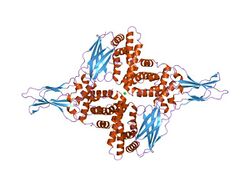Biology:Interferon gamma receptor (IFNGR1) family
From HandWiki
| Interferon gamma receptor (IFNGR1) | |||||||||
|---|---|---|---|---|---|---|---|---|---|
 1:1 complex between an interferon gamma single-chain variant and its receptor | |||||||||
| Identifiers | |||||||||
| Symbol | IFNGR1 | ||||||||
| Pfam | PF07140 | ||||||||
| Pfam clan | CL0159 | ||||||||
| InterPro | IPR008355 | ||||||||
| SCOP2 | 1fg9 / SCOPe / SUPFAM | ||||||||
| Membranome | 1318 | ||||||||
| |||||||||
In molecular biology, the interferon gamma receptor (IFNGR1) family is a family of proteins which includes several eukaryotic and viral interferon gamma receptor proteins.
Members of this family include:
- The human interferon gamma receptor 1, which is a member of the hematopoietic cytokine receptor superfamily. It is expressed in a membrane-bound form in many cell types, and is over-expressed in tumour cells. It comprises an extracellular portion of 229 amino acid residues, a single transmembrane region, and a cytoplasmic domain of 221 amino acid residues. As with other members of its superfamily, the cytokine-binding sites are formed by a small set of closely spaced surface loops that extend from a beta-sheet core, much like antigen-binding sites on antibodies.[1]
- The vaccinia virus interferon (IFN)-gamma receptor (IFN-gammaR), which is a 43 kDa soluble glycoprotein that is secreted from infected cells early during infection. IFN-gammaR from vaccinia virus, cowpox virus and camelpox virus exist naturally as homodimers, whereas the cellular IFN-gammaR dimerises only upon binding the homodimeric IFN-gamma. The existence of the virus protein as a dimer in the absence of ligand may provide an advantage to the virus in efficient binding and inhibition of IFN-gamma in solution.[2]
References
- ↑ "Neutralizing epitopes on the extracellular interferon gamma receptor (IFNgammaR) alpha-chain characterized by homolog scanning mutagenesis and X-ray crystal structure of the A6 fab-IFNgammaR1-108 complex". J. Mol. Biol. 273 (4): 882–97. November 1997. doi:10.1006/jmbi.1997.1336. PMID 9367779.
- ↑ Alcami A, Smith GL (March 2002). "The vaccinia virus soluble interferon-gamma receptor is a homodimer". J. Gen. Virol. 83 (Pt 3): 545–9. doi:10.1099/0022-1317-83-3-545. PMID 11842249.
 |

